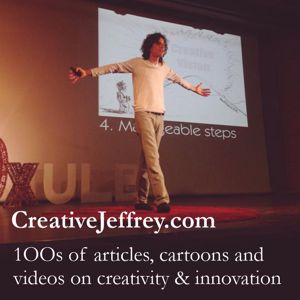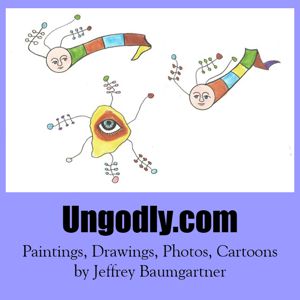Report 103
Your newsletter on applied creativity, imagination, ideas and innovation in business.
Tuesday, 3 January 2006
Issue 73
Hello and welcome to another issue of Report 103, your fortnightly newsletter on creativity, imagination, ideas and innovation in business.
As always, if you have news about creativity, imagination, ideas, or innovation please feel free to forward it to me for potential inclusion in Report103. Your comments and feedback are also always welcome.
Information on unsubscribing, archives, reprinting articles, etc can be found at the end of this newsletter.
HAPPY INNOVATIVE 2006!
Best wishes to you and yours for a happy, successful and prosperous 2006!
Over the previous year, we saw an upsurge in corporate interest in innovation. Even the word “creativity” has become acceptable in the corporate setting. Not long ago, the word creativity was only considered applicable to certain divisions in advertising agencies.
Of course, companies have been talking about innovation for a long time. But 2005 seemed to be the year when mainstream companies went beyond simply talking and starting looking into and sometimes even implementing innovation plans. Unfortunately, a number of companies have bought into highly complex systems which cost a fortune in consulting fees, software and software customisation; but which have not and will not substantially improve their innovativeness (see The Great Innovation Lie in the 6 December 2005 issue of Report 103 (http://www.creativejeffrey.com/report103/archive.php?issue_no=20051206).
2006 will doubtless see the trend continue as more and more mainstream companies adopt innovation strategies, implement idea management software and attempt to become more innovative. Some will succeed. Some will not. Those that succeed will do so by adopting relatively simple tactics. They will...
-
Ensure staff have time to be creative (see Organisational Creativity – the Top 10 enablers in the 4 October 2005 issue of Report 103 – http://www.creativejeffrey.com/report103/archive.php?issue_no=20051004). In a recent study, lack of time was sited as the number one hurdle to corporate creativity and innovation: not having time to be creative.
-
Provide an environment of trust, where staff feel comfortable sharing ideas – even outlandish ideas. When trust does not flow; ideas do not either.
-
Provide a budget for implementing the occasionally risky idea.
-
Reward those who contribute good ideas.
-
Allow people to make mistakes – provided they are not making the same mistake over and over again – and ensure they learn from those mistakes.
-
Encourage and facilitate cross-enterprise collaboration between people of different divisions and in different locations.
-
Implement a structured (but not strict) idea management solution to solicit and develop ideas from the workforce.
-
Implement ideas (it never ceases to amaze me how many organisations develop idea management systems, run expensive brainstorming sessions and encourage ideas from the work force, only to avoid implementing the creative ideas generated by those methods).
How about you? How will your firm fare for innovation in 2006?
MORE INFORMATION WANTED FROM YOU
I have a dilemma. I would like to be able to ask you, individually, questions about creativity and innovation in your firm and in your life. This information would be used in Report 103 and in our general research. However, neither your name, your company's name nor any identifying information would be published without your explicit permission.
In order to ask you those questions, I need your permission. The subscription form for Report 103 makes it quite clear that we will not contact you, other than to send our e-journal, unless you contact us first.
Note, if you do this, we will ONLY contact you with questions about innovation and creativity in your own experience or in your firm. We will not make any sales pitches, send you any marketing material or share your information outside our firm. Moreover, you may at any time ask us to remove your contact information from our list.
Thank you!
DISCOVERING OPERATIONAL INNOVATION OPPORTUNITIES
A great place to discover opportunities to improve your operational efficiency
through innovative new approaches that do not require reducing your workforce
is...
Your staff canteen!
No, it's not about improving the efficiency of feeding staff, nor is it about providing a healthier diet so staff think better (although that is a jolly good idea!). Rather it is about listing. That's because when an employee goes to lunch, frustrated by your company's operational inefficiencies, she will let off steam by moaning to her colleagues about the problem. If the problem is one that affects others, they will agree and moan together. Sometimes, mini brainstorming sessions will even break out with people building on each others' suggestions for improving the problem.
I've seen this happen at every company with a staff canteen. I expect you have as well. When staff go to lunch they relax, don't have to worry about finishing off this task or that task and can allow themselves to open their minds and think freely. Something many people cannot do at their desks.
As a result, if you want to find out what your workforce thinks needs improving on the operational side of things, all you need do is go to the canteen, open your ears and listen. Unfortunately, if you are a senior manager, there is a good chance that either:
1) You eat with other senior managers, often away from the staff canteen; or...
2) When you do sit down in the staff canteen with regular employees, the employees become elusive and stop complaining about problems.
If this is the case, your best bet is to send in a “spy”; someone who can join other employees at lunch, join in conversations and pay attention to moans and complaints. Of course it must be emphasised that the point behind the spy's mission is not to pinpoint complainers or identify people who stir up trouble (indeed, if a senior manager were even contemplating such an action, her company would already have serious innovation problems owing to lack of trust – but that's another story). The point is to identify innovation opportunities.
You, or your spy, should listen for themes; in other words, issues that crop up again and again at lunchtime. For instance, at a recent company I worked with two such recurring themes were:
1) Inefficient invoicing system. At this company number of steps had to be followed in a specific order before an invoice could be sent to the client. However, it sometimes took two months or more after a project was completed before all the steps were finished in order and an invoice could be sent. This led to slow payments, confused customers (“what's this invoice for?” they would call and ask) and frequent invoicing mistakes.
2) Appalling in-house communication between divisions. This is a common problem in many companies, but here it was worse owing to hierarchical rules regarding who communicated with whom and how. Moreover, managers were highly secretive about their activities, making matters worse.
Of course staff at this company had a number of ideas on how to solve both problems. Some of those ideas were good, some were not. Some ideas could be combined with others to provide even better solutions.
Once you have collected a problem or two from the canteen, your next step is to launch an ideas campaign challenge (an ideas campaign, for new readers, is like a massive, collaborative brainstorming session that allows everyone in the firm to contribute and build upon each others' ideas over a period of 2-6 weeks – at the end of the campaign, ideas are evaluated and the best ideas implemented – for more information on ideas campaigns – see http://www.creativejeffrey.com/jenni/) for each opportunity identified. Each campaign should, of course, be run separately.
In the above example, the ideas campaign challenges might be...
1) “How could we improve the efficiency of our invoicing process?”
2) “How could we improve our internal communication flow?”
A less obvious ideas campaign challenge also suggested by the problems at example company is:
“How can we remove bureaucratic obstacles that hinder the efficient operation of our organisation?”
An added advantage to running ideas campaigns on operational issues complained about in the staff canteen is that doing so does wonders for morale. If employees see that the company is trying to improve the problems that drive them crazy, they will have greater respect for the company.
If you do not have a staff canteen, don't worry. There are other places where people moan about operation problems. They include the area around the coffee machine and nearby pubs where employees like to go for a drink after work.
TRANSPARENT AND TRANSLUCENT REWARDS FOR INNOVATION
There are two kinds of rewards for employees who contribute innovative ideas to the firm: (1) transparent or direct rewards and (2) translucent or indirect rewards.
Transparent Rewards
Transparent rewards are those that are publicly given for contributing or collaborating
on an idea. When most innovation experts talk about rewarding ideas, they are
referring to transparent rewards.
Transparent rewards should not be substantial. Indeed, the worst kind of rewards are large cash rewards or massive bonuses tied to the monetary value of an implemented idea. Large cash rewards tend to cause people to become greedy and greedy behaviour is deadly for innovation. After all, the point of any innovation strategy is to encourage people to help the firm grow via innovative ideas. When people get greedy, they are only looking after their own monetary desires.
Transparent rewards can include:
-
Public recognition for contributing innovative ideas.
-
Points for ideas (if you are using an idea management system like Jenni - http://www.creativejeffrey.com/jenni/ - there is a points management tool for granting points to people who contribute and build on ideas).
-
Small gifts such as cameras, CDs, restaurant vouchers and so on.
-
Work related benefits such as extra time off, allowance to attend international conferences and the like.
-
Being given the responsibility (and budget) to test or implement a proposed idea.
Transparent rewards are critical for any idea management or other innovation system. If employees are not rewarded in any way for their creative contributions, they will soon stop offering their ideas.
Translucent Rewards
Translucent rewards are rewards that are not so obviously related to the contribution
of a specific idea. Translucent rewards are more about long term innovation
performance as well as general job performance. However, translucent rewards
can also be given to reward indirectly the people who have contributed a major
idea to the organisation. Translucent rewards are not directly tied to innovation
or your innovation strategy. Nevertheless, employees will see that innovative
people in the firm grow with the firm through translucent rewards.
Translucent rewards include promotions, pay increases and benefit increases. A person who regularly contributes good ideas to the company can be rewarded via promotion into a position that would not only reward her for her innovativeness, but also allow the company to benefit better from her innovativeness.
Likewise, the person who contributes a powerful idea which earns the company (or saves the company) substantial income can eventually be given a promotion. However, that promotion should not come immediately after the idea has been identified as a powerful one – otherwise the translucent reward becomes a transparent one and can wreck havoc on your transparent rewards system.
If appropriate, the promotion should involve the idea contributor with the implementation of her idea. If she has management potential, she could even be put in charge of implementing the idea.
Translucent rewards ensure that the people who contribute powerful ideas do, in the long run, receive financial and responsibility benefits to reflect their overall contributions. More importantly, translucent rewards ensure that the people who contribute powerful ideas continue to contribute those powerful ideas to the company, rather than to the competition or to their own start-up companies (something a lot of innovative people do, actually).
Translucent rewards can also be a means of ensuring that people are promoted in a way that reflects their creativity and innovativeness. A person who is good at initiating ideas, but not at implementing them, can be given a more strategic role which takes advantage of her imagination and ability to look at the big picture better than the details. Someone who is good at building on other people's ideas might be put in charge of managing new projects. And so on.
Promoting your most creative people is important. A mistake a lot of companies make with creative people is to think: “she's a bit of a rebel, but she is really good in this position. Let's keep her there so she can continue to do the same kind of creative work over the long term.” In fact, a creative thinker left to do the same work for too long will grow bored and less creative. Over the long term, she will almost certainly leave for a more challenging position somewhere else.
Indeed, the best on-going translucent reward you can offer people is a steady stream of new challenges through promotions.
Happy thinking!
Jeffrey Baumgartner
Report 103 is a complimentary weekly electronic newsletter from Bwiti bvba of Belgium (a jpb.com company: http://www.creativejeffrey.com). Archives and subscription information can be found at http://www.creativejeffrey.com/report103/
Report 103 is edited by Jeffrey Baumgartner (jeffreyb@jpb.com) and is published on the first and third Tuesday of every month.
You may forward this copy of Report 103 to anyone, provided you
forward it in its entirety and do not edit it in any way. If you wish to reprint
only a part of Report 103, please contact Jeffrey Baumgartner.
Contributions and press releases are welcome. Please contact Jeffrey in the first instance.




